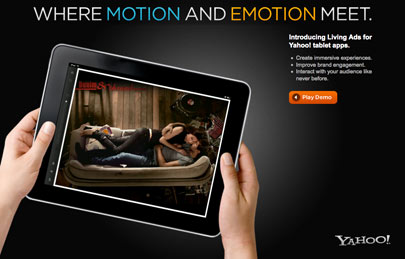Yahoo Rolls Out 'Livestand' Reader App
- by Mark Walsh @markfwal, November 2, 2011

Nine months after announcing its Livestand newsreader, Yahoo on Wednesday finally launched its tablet app packaging Yahoo and third-party content in a magazine-style interface that includes a new custom ad format.
Livestand enters an already crowded digital newsstand niche including startups such as Flipboard, Zite (acquired by CNN in August) and Pulse, as well as AOL’s Editions. Google is reportedly preparing to debut its own tablet news magazine, code-named Propeller. Flipboard has emerged as the biggest name in the space, with the company raking in more than $60 million so far in venture funding and its app racking up 3.5 million downloads.
Yahoo aims to catch up by leveraging its huge reach, relationships with content providers, and marketing muscle to plug its audience into Livestand. For one thing, people can use their Yahoo or Facebook logins to access the app, which is launching on the iPad but next year will extend to Android-based tablets and smartphones.
In addition to offering content from Yahoo properties including News, Sports, Finance, and omg!, Livestand launches with select material from more than 100 titles and topics from publishers including Forbes, Bonnier, ABC News and Source Interlink Media.
Publications appear as tiles in a carousel format from which users can assemble their own library of titles, and content is updated daily. Users can also create a personalized digital magazine by tagging topics and articles and share what they are reading via Facebook or email.
Unlike most competing newsreader apps, Yahoo is building advertising into Livestand from the outset. The main attraction is the “LivingAd” unit that rolls out with the app. The oversized format produces a visual effect similar to the dynamic newspaper photos of the Harry Potter films, suggesting motion in otherwise static images.
The ads, which run as full-page interstitials or on the right rail, also incorporate motion-sensing capability and allow users to zoom in and interact with different parts of the ad using the touchscreen. Advertising options for the app also include more standard rich media and display units.
Charter sponsors for Livestand employing the new custom ad are Toyota and DreamWorks Pictures. The Japanese automaker will be running a Living Ad execution along with a rich media unit to promote the new Prius v launching in November.
DreamWorks will kick off a rich media campaign for its upcoming holiday release, “War Horse,” opening Dec. 25.
Yahoo is asking advertisers to pay as much as $500,000 for buys centered on the new unit, according to an Advertising Age story Tuesday. A Yahoo spokesman Tuesday said ad packages for Livestand will range in price from $200,000 to $500,000.
Third-party publishers, as well as Yahoo, can sell advertising against their content on Livestand. Yahoo did not disclose details of revenue-sharing agreements with publishers, however.
Phuc Truong, who heads Mobext, Havas Digital's mobile marketing arm, said the agency has a handful of clients looking at the Living Ad offering. “It caught my eye. I think if you can attract the user on a page with something engaging, that’s half the battle,” he said.
Truong added that Livestand’s slick interface and personalization features, along with Yahoo’s massive user base, should make the app an immediate contender in the tablet magazine category.
Michael Collins, CEO of Joule, GroupM’s mobile marketing unit, agreed that the LivingAds were innovative and well-suited to the tablet platform. “The ability to get scale and get it in front of a relevant audience is going to be the big challenge,” said Collins, who was briefed by Yahoo on Livestand last month.If still relatively small, he acknowledged
the affluent, early-adopter tablet audience would be a good fit -- especially for luxury brands and financial services markets. Collins said he has not yet discussed ad possibilities in Livestand with
Joule clients. But whether marketers will be willing to pay the hefty price tag for reaching that audience through the app isn't clear. After seeking ad commitments of $1 million from launch
advertisers for its iAd in-app ad format last year, Apple has since pulled back to about $300,000.
Other newsreader apps are just beginning to introduce advertising into their apps. Flipboard, for instance, rolled out advertising in July with full-page ads from brands including American Express and Lexus in content from Conde Nast titles including The New Yorker, Bon Appetit and Wired.
Underpinning the various tablet reader initiatives is the growing consumer embrace of tablets. Overall media tablet sales worldwide are on pace to reach 63.6 million units -- up 261% from 17.6 million units last year, according to a Gartner forecast in September. The iPad is expected to account for three-quarters of those sales.But despite the buzz surrounding the likes of Flipboard and Pulse, these digital newsstands accounted for only 9% of the news sources cited by participants in a PewResearch Center survey on tablet usage released last week. That’s because news consumers tend to go directly to specific news sites or apps on their devices.
Among the roughly 10% of U.S. adults who own a tablet, more than half (53%) access news on their tablet every day, reading long articles as well as checking headlines, according to the survey.


